35 Ton Overhead Crane for Sale, Types and Their Applications
35 ton overhead cranes for sale. Overhead cranes with hoist trolley & open winch trolley for heavy loads handling in various industrial sectors. Check now!
When it comes to heavy lifting and material handling in industrial settings, 35 ton overhead cranes are invaluable tools. This guide aims to provide a comprehensive overview of these powerful machines, focusing on their types, features, and applications. Understanding the capabilities and benefits of 35 ton overhead cranes can help businesses make informed decisions, ensuring they select the right equipment for their specific needs.
Overview of 35 Ton Overhead Cranes
A 35 ton overhead crane is designed to lift and transport loads up to 35 tons, making it a robust and versatile piece of machinery in various industrial sectors. These cranes are typically used for heavy-duty lifting tasks that involve moving large, heavy objects with precision and efficiency. The two main types of 35 ton overhead cranes are double girder and top running, which offer different benefits based on their design and the lifting systems they incorporate.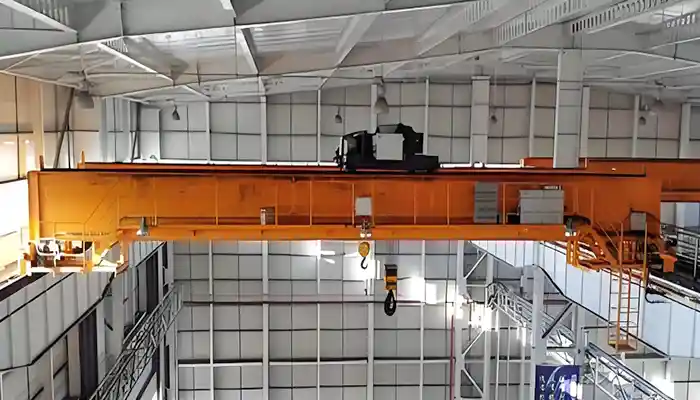
Importance in Industrial Applications
- Efficiency and Productivity : Overhead cranes significantly enhance productivity by allowing the rapid and safe movement of heavy materials. This efficiency reduces the time and labor required for manual handling, speeding up production processes and reducing downtime.
- Safety : Using overhead cranes minimizes the risk of injuries associated with manual lifting and handling of heavy objects. These cranes are equipped with advanced safety features to ensure the safe transport of materials, protecting both workers and equipment.
- Versatility : 35 ton overhead cranes are used across a wide range of industries, from manufacturing and construction to mining and logistics. Their ability to handle various types of loads makes them essential for diverse applications, from moving heavy machinery to loading and unloading goods.
- Precision : These cranes provide precise control over the lifting and placement of loads, which is crucial in industries where accuracy is essential. This precision helps prevent damage to materials and ensures smooth operations.
In conclusion, 35 ton overhead cranes play a crucial role in enhancing operational efficiency, ensuring safety, and providing versatile and precise material handling solutions in industrial applications. Understanding their features and benefits is the first step towards optimizing their use in your specific industry.
Double Girder Top Running Overhead Crane
35 ton overhead cranes come in various configurations, each designed to meet specific industrial needs. Double Girder Top Running Overhead Crane stands out due to its robust design and superior load handling capabilities. The Double Girder Top Running Overhead Crane is a heavy-duty crane system ideal for lifting and moving large, heavy loads. It consists of two girders that run parallel to each other along the top of the crane structure. These girders provide a stable and strong framework that supports the lifting mechanism, typically a trolley with a hoist or an open winch.
Features
Robust Construction: The double girder design offers enhanced strength and durability, making it suitable for heavy lifting tasks.
High Lifting Capacity: Capable of handling loads up to 35 tons, making it ideal for industrial applications requiring significant lifting power.
Precision Control: Equipped with advanced control systems that allow precise movement and placement of loads.
Customization Options: Can be customized with various lifting systems and below hook devices to suit specific application needs.
Structure
Main Girders: Two parallel girders form the main structural element, providing a sturdy track for the trolley.
End Trucks: These components support the girders and facilitate smooth movement along the runway.
Trolley and Hoist: The trolley runs along the girders and carries the hoist, which performs the lifting operation.
Control System: Includes pendant control, wireless remote control, or a cab for the operator, ensuring safe and efficient crane operation.
Advantages
Higher Lifting Height: The double girder design allows for a higher lifting height compared to single girder cranes, making it suitable for applications where maximum vertical space utilization is crucial.
Greater Load Capacity: The robust structure and design enable it to handle heavier loads, providing reliability and efficiency for demanding industrial tasks.
Enhanced Stability: The two-girder setup offers better load distribution and stability, ensuring safe and smooth lifting operations.
Versatility: Can be equipped with various lifting devices and customized to meet the specific requirements of different industries and applications.
Disadvantages
Higher Cost: The complexity and materials involved in the double girder design result in a higher initial cost compared to simpler crane types.
More Complex Installation: The installation process is more involved, requiring precise alignment and additional structural support, which can increase setup time and cost.
In conclusion, the Double Girder Top Running Overhead Crane is a powerful and versatile solution for heavy lifting in industrial environments. Its high lifting capacity, precision control, and robust construction make it an invaluable asset for operations requiring reliable and efficient material handling. However, the higher cost and complexity of installation are factors to consider when selecting the right crane for your needs.
Lifting Systems
When it comes to lifting heavy loads with precision and efficiency, the choice of lifting system plays a crucial role. Among the various options available, the Hoist Trolley stands out as a popular choice for 35 ton overhead cranes. Let's delve into its features, advantages, and disadvantages to understand why.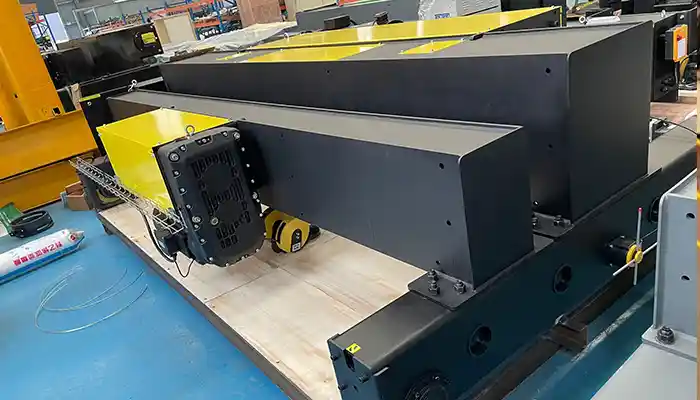 European style hoist trolley
European style hoist trolley 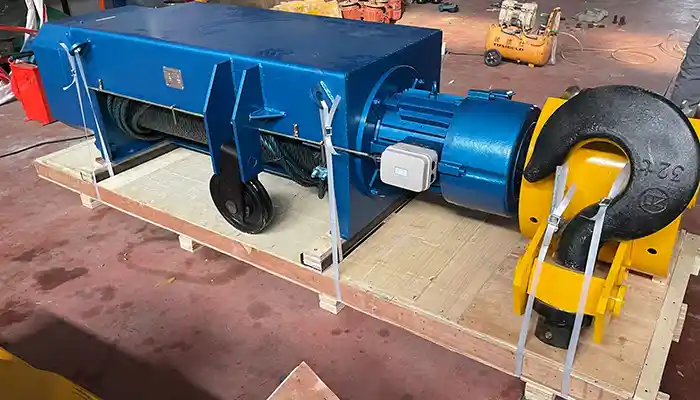 Electric hoist for double girder overhead crane 35 ton
Electric hoist for double girder overhead crane 35 ton
Hoist Trolley
The hoist trolley is a fundamental component of the overhead crane system, responsible for lifting and moving loads along the crane's runway. It consists of a hoist mechanism mounted on a trolley that runs along the bridge girder.
Features:
Compact Design: The hoist trolley is designed to be compact, allowing it to navigate tight spaces and operate efficiently in confined areas.
Robust Structure: Despite its compact size, the hoist trolley is built to withstand heavy loads and rigorous industrial environments.
Versatile Operation: It can be equipped with various below hook devices, such as hooks, slings, or lifting attachments, to accommodate different load types and shapes.
Advantages:
Compact Design: The small footprint of the hoist trolley makes it ideal for use in facilities where space is limited, maximizing usable floor space.
Easy to Maintain: With fewer moving parts compared to other lifting systems, the hoist trolley is relatively easy to maintain, reducing downtime and maintenance costs.
Versatile: It can handle a wide range of loads, from small components to large machinery, providing flexibility in material handling operations.
Disadvantages:
Limited Speed: Due to its compact design and smaller motor size, the hoist trolley may have limited lifting and travel speeds compared to other lifting systems.
Less Suitable for Very Heavy Loads: While capable of handling substantial loads, the hoist trolley may not be as suitable for extremely heavy loads approaching the upper limit of the crane's capacity.
In summary, the hoist trolley offers a compact and versatile solution for lifting and moving loads in industrial settings. Its compact design and ease of maintenance make it a practical choice for facilities where space is limited and uptime is critical. However, its limited speed and suitability for very heavy loads are factors to consider when determining the best lifting system for your specific application.
Open Winch Trolley
Description: The open winch trolley is a robust lifting system commonly used in 35 ton overhead cranes. It features a winch mechanism mounted on a trolley that traverses the bridge girder, allowing for precise lifting and movement of heavy loads.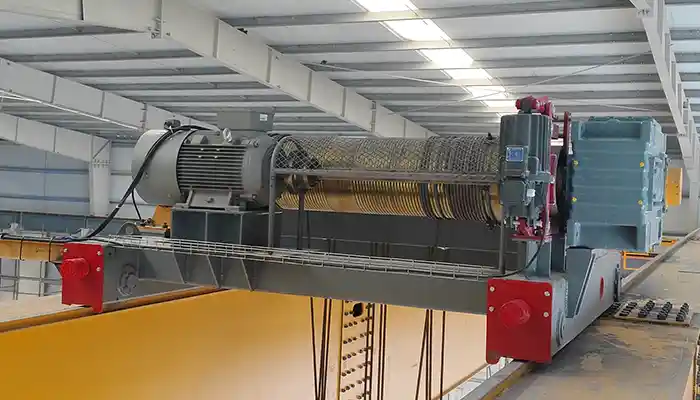 Open winch trolley for heavy duty overhead crane 35 ton
Open winch trolley for heavy duty overhead crane 35 ton 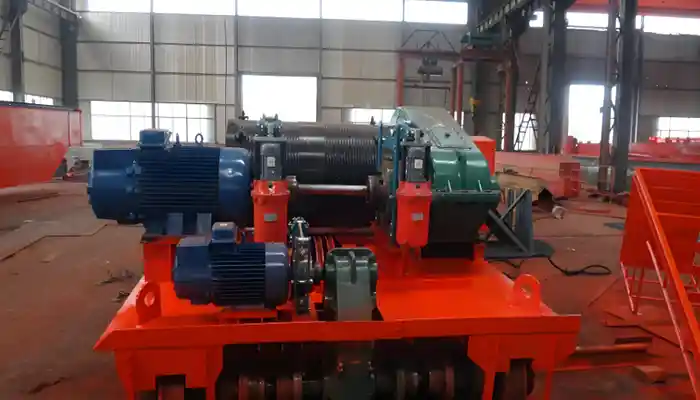 Chinese style open winch trolley for heavy duty bridge crane
Chinese style open winch trolley for heavy duty bridge crane
Features:
Heavy-Duty Construction: The open winch trolley is built to withstand the rigors of heavy lifting operations in industrial environments.
High Lifting Capacity: With its powerful winch mechanism, this lifting system is capable of handling very heavy loads up to 35 tons.
Precision Control: Equipped with advanced control systems, the open winch trolley allows for precise positioning of loads with minimal effort.
Advantages:
High Lifting Speed: The open winch trolley boasts impressive lifting speeds, allowing for rapid movement of loads and increased productivity.
Suitable for Very Heavy Loads: With its high lifting capacity, this lifting system is ideal for handling extremely heavy loads that may exceed the capabilities of other lifting systems.
Disadvantages:
Larger and Heavier: Compared to other lifting systems, the open winch trolley is larger and heavier, requiring robust structural support and potentially increasing the overall weight of the crane system.
More Complex Maintenance: Due to its more intricate design and larger number of moving parts, the open winch trolley may require more frequent and involved maintenance procedures, leading to increased downtime and maintenance costs.
In summary, the open winch trolley offers exceptional lifting power and speed, making it a preferred choice for handling very heavy loads in industrial applications. However, its larger size and more complex maintenance requirements are factors to consider when selecting the appropriate lifting system for your specific needs.
Below Hook Devices
When it comes to material handling with 35 ton overhead cranes, below hook devices play a crucial role in ensuring efficient and safe lifting operations. Let's explore the different types of below hook devices available, their descriptions, uses, and selection criteria.
Types
- Magnet Lifters : Magnet lifters utilize electromagnetism to lift and transport ferrous materials such as steel plates, sheets, and bars. These devices are commonly used in industries such as steel manufacturing, metal fabrication, and scrap yards.
- Grab Buckets : Grab buckets are designed to handle bulk materials such as sand, gravel, and loose debris. They feature mechanical or hydraulic mechanisms that allow them to open and close, enabling efficient loading and unloading of materials in industries such as construction, mining, and agriculture.
- C-Hooks : C-hooks are specifically designed for lifting and transporting coils, rolls, and other cylindrical objects. They feature a C-shaped design that securely cradles the load, preventing slippage during transport. C-hooks are commonly used in steel mills, paper mills, and manufacturing facilities.
- Lifting Beams/Spreaders : Lifting beams, also known as spreaders, are versatile devices used for lifting and handling various types of loads, including containers, machinery, and structural components. They consist of a horizontal beam with multiple attachment points for securing the load, providing stability and even weight distribution.
Selection Criteria
When selecting below hook devices for use with 35 ton overhead cranes, several factors should be considered to ensure optimal performance and safety:
Type of Load: Choose a below hook device that is specifically designed to handle the size, shape, and weight of the load being lifted.
Safety Requirements: Consider safety features such as load-sensing mechanisms, overload protection, and secure attachment points to prevent accidents and ensure compliance with safety regulations.
Operational Efficiency: Select below hook devices that offer ease of use, minimal downtime, and compatibility with the crane's lifting capacity and operational requirements.
In summary, below hook devices are essential accessories for 35 ton overhead cranes, allowing for efficient and safe material handling in various industrial applications. By understanding the different types of below hook devices available and considering key selection criteria, businesses can maximize the effectiveness of their crane systems and improve overall operational efficiency.
Working Environments and Special Designs
In industrial settings, the working environment can vary significantly, presenting unique challenges for material handling equipment such as 35 ton overhead cranes. Specialized designs are often required to ensure safe and efficient operation in hazardous environments and meet specific industrial requirements. Let's explore some of these considerations in more detail.
Hazardous Environments
- Explosion-Proof Designs: Overhead cranes used in hazardous environments, such as chemical plants or oil refineries, must be equipped with explosion-proof features to prevent ignition sources from causing explosions. These cranes are constructed with sealed electrical components and non-sparking materials to minimize the risk of sparks or overheating.
- Dust and Moisture Resistance: In environments with high levels of dust, moisture, or other contaminants, overhead cranes must be designed to withstand these harsh conditions. Sealed enclosures, corrosion-resistant finishes, and protective coatings are often used to prevent damage and ensure reliable operation.
Outdoor Use
- Weatherproofing: Overhead cranes installed in outdoor environments are exposed to weather elements such as rain, snow, and extreme temperatures. Weatherproofing measures, such as sealed electrical components, waterproof seals, and corrosion-resistant materials, are essential to protect the crane from environmental damage and ensure continuous operation.
- Corrosion-Resistant Materials: Outdoor cranes are susceptible to corrosion from exposure to moisture and harsh chemicals. Using corrosion-resistant materials such as stainless steel or galvanized steel helps prolong the lifespan of the crane and reduces maintenance requirements.
Special Industrial Requirements
- High-Temperature Environments: Industries such as steel manufacturing or glass production operate in high-temperature environments that can exceed the limits of standard overhead cranes. Specialized cranes with heat-resistant components and insulation are required to withstand these extreme conditions safely.
- Cleanroom Standards: Cleanroom environments, such as those found in pharmaceutical or semiconductor manufacturing, have strict cleanliness requirements to prevent contamination. Overhead cranes used in these environments must be designed to minimize particle generation and meet stringent cleanliness standards.
In summary, working environments and special design considerations play a crucial role in determining the suitability of 35 ton overhead cranes for specific industrial applications. By understanding the unique challenges posed by hazardous environments, outdoor use, and special industrial requirements, businesses can select the appropriate crane design to ensure safe and efficient material handling operations.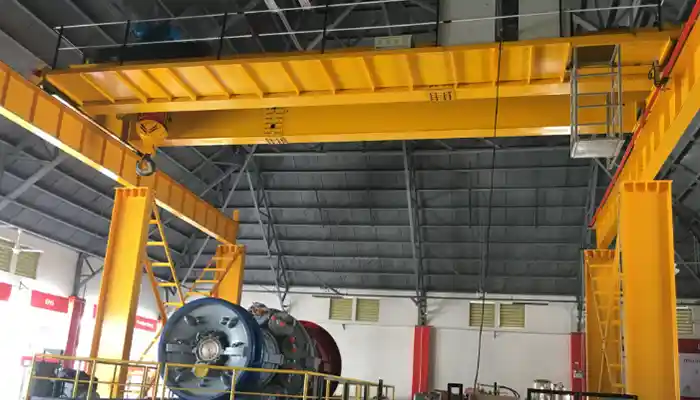 Electric hoist trolley overhead crane
Electric hoist trolley overhead crane
Typical Applications and Uses in Various Industries
Manufacturing Industry
In the manufacturing industry, 35 ton overhead cranes play a pivotal role in facilitating efficient material handling processes. Let's explore the typical applications and uses of these cranes in this industry.
Types of Loads Handled:
Heavy Machinery: 35 ton overhead cranes are adept at lifting and transporting heavy machinery components such as engines, turbines, and large equipment parts.
Raw Materials: These cranes are also used to handle raw materials such as steel beams, coils, and ingots, which are essential for the manufacturing process.
Applications:
Assembly Lines: 35 ton overhead cranes are deployed along assembly lines to assist in the construction of large machinery and equipment. They facilitate the movement of components between workstations, ensuring a smooth and efficient production process.
Machine Part Handling: These cranes are utilized for lifting and positioning machine parts during manufacturing operations. They provide precision control and maneuverability, allowing operators to safely handle delicate components with ease.
In the manufacturing industry, the use of 35 ton overhead cranes optimizes production efficiency, reduces labor costs, and enhances workplace safety. Their versatility and capability to handle heavy loads make them indispensable assets for manufacturers striving for operational excellence.
Steel Industry
The steel industry relies heavily on efficient material handling solutions to facilitate the processing and transportation of heavy steel products. 35 ton overhead cranes play a vital role in this industry, enabling seamless operations and maximizing productivity.
Types of Loads Handled:
Steel Coils: 35 ton overhead cranes are utilized for lifting and transporting steel coils, which are commonly used in the manufacturing of various products such as automotive parts, appliances, and construction materials.
Sheets and Plates: These cranes are also employed for handling steel sheets and plates, which are essential components in construction, manufacturing, and fabrication industries.
Applications:
Loading and Unloading: 35 ton overhead cranes are deployed for loading and unloading steel coils, sheets, and plates onto trucks, trains, or storage racks. They ensure efficient and safe handling of heavy steel materials, minimizing the risk of damage or accidents.
Transportation Within the Facility: Within steel manufacturing facilities, these cranes are used to transport steel products between different production processes, storage areas, and shipping docks. They provide precise control and maneuverability, allowing for seamless material flow and workflow optimization.
In the steel industry, the use of 35 ton overhead cranes enhances operational efficiency, reduces downtime, and ensures the timely delivery of high-quality steel products to customers. Their robust construction and heavy lifting capabilities make them indispensable tools for steel manufacturers striving for excellence in material handling.
Construction Industry
In the construction industry, efficient material handling is essential for the timely completion of projects and ensuring worksite safety. 35 ton overhead cranes play a crucial role in facilitating the movement and placement of heavy construction materials, contributing to the success of construction projects.
Types of Loads Handled:
Concrete Panels: 35 ton overhead cranes are utilized for lifting and positioning concrete panels, which are commonly used in building construction for walls, floors, and other structural elements.
Steel Beams: These cranes are also employed for handling steel beams, which are essential components in constructing building frames, bridges, and other large structures.
Applications:
Material Lifting and Placement: 35 ton overhead cranes are deployed for lifting heavy construction materials, such as concrete panels and steel beams, to various heights and locations within the construction site. They ensure precise placement of materials, optimizing construction workflow and minimizing manual labor.
Structural Assembly: Within construction projects, these cranes are used for assembling structural components such as steel beams and trusses. They provide the necessary lifting capacity and maneuverability to position components accurately, facilitating the construction of sturdy and durable structures.
In the construction industry, the use of 35 ton overhead cranes improves productivity, enhances worksite safety, and streamlines construction processes. Their versatility and ability to handle heavy loads make them indispensable assets for construction companies striving for excellence in material handling and project execution.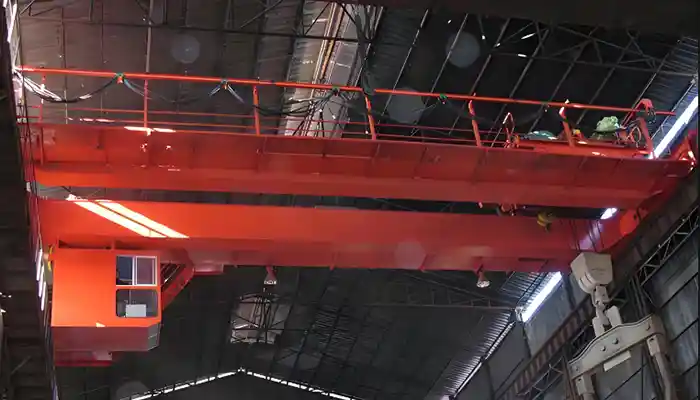 QD open winch trolley double girder overhead crane
QD open winch trolley double girder overhead crane
Warehouse and Logistics
Efficient material handling is crucial in warehouse and logistics operations to ensure the smooth flow of goods and timely fulfillment of orders. 35 ton overhead cranes play a significant role in warehouse and logistics facilities, facilitating the movement and storage of heavy and bulky items.
Types of Loads Handled:
Palletized Goods: 35 ton overhead cranes are utilized for lifting and transporting palletized goods, such as boxes, crates, and containers, which are commonly used in warehouse storage and distribution.
Large Containers: These cranes are also employed for handling large containers, bins, or bulk storage units, which may contain goods or materials of various shapes and sizes.
Applications:
Inventory Management: 35 ton overhead cranes are deployed for organizing and managing inventory within warehouse facilities. They enable efficient storage and retrieval of goods, optimizing warehouse space utilization and inventory tracking processes.
Loading and Unloading Trucks: Within logistics operations, these cranes are used for loading and unloading trucks, trailers, or shipping containers. They facilitate the efficient transfer of goods between storage areas and transportation vehicles, minimizing loading/unloading times and ensuring timely shipments.
In warehouse and logistics environments, the use of 35 ton overhead cranes enhances operational efficiency, reduces manual labor requirements, and improves overall throughput. Their versatility and ability to handle heavy loads make them indispensable tools for warehouse managers and logistics professionals striving to optimize their material handling processes.
Mining Industry
In the mining industry, where rugged terrain and heavy machinery are commonplace, efficient material handling solutions are essential for maintaining productivity and safety. 35 ton overhead cranes play a crucial role in supporting mining operations by facilitating the movement and maintenance of heavy equipment and raw materials.
Types of Loads Handled:
Heavy Mining Equipment: 35 ton overhead cranes are utilized for lifting and transporting heavy mining equipment such as excavators, bulldozers, and drilling rigs, which are essential for excavation and ore extraction.
Raw Materials: These cranes are also employed for handling raw materials such as ore, coal, and minerals, which are extracted from mining sites and transported for processing.
Applications:
Equipment Maintenance: Within mining operations, 35 ton overhead cranes are used for lifting and positioning heavy equipment during maintenance and repair tasks. They provide the necessary lifting capacity and precision control to ensure safe and efficient equipment servicing.
Material Transport: These cranes are deployed for transporting raw materials, equipment components, and other heavy loads within mining facilities. They facilitate the movement of materials between mining sites, processing plants, and storage areas, optimizing material flow and logistics operations.
In the mining industry, the use of 35 ton overhead cranes enhances operational efficiency, reduces downtime, and improves workplace safety. Their robust construction and heavy lifting capabilities make them indispensable assets for mining companies striving to maintain productivity and profitability in challenging mining environments.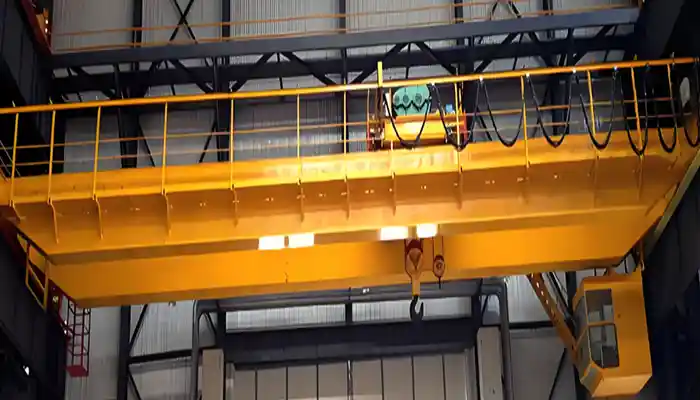 Open winch open winch trolley with double hooks
Open winch open winch trolley with double hooks
Automotive Industry
Efficient material handling is crucial in the automotive industry to ensure the smooth production of vehicles and timely delivery of parts and components. 35 ton overhead cranes play a vital role in supporting automotive manufacturing operations by facilitating the movement and assembly of car parts and components.
Types of Loads Handled:
Car Parts: 35 ton overhead cranes are utilized for lifting and transporting various car parts such as engines, transmissions, chassis components, and body panels.
Assemblies: These cranes are also employed for handling assembled components such as car doors, hoods, and seats, which are essential for vehicle production.
Applications:
Assembly Lines: Within automotive manufacturing plants, 35 ton overhead cranes are deployed along assembly lines to assist in the construction of vehicles. They facilitate the movement of components between workstations, ensuring a smooth and efficient production process.
Maintenance and Repair: These cranes are used for lifting and positioning heavy vehicle components during maintenance and repair tasks. They provide the necessary lifting capacity and precision control to support maintenance operations, reducing downtime and ensuring vehicle reliability.
In the automotive industry, the use of 35 ton overhead cranes enhances production efficiency, reduces manual labor requirements, and improves overall throughput. Their versatility and ability to handle heavy loads make them indispensable tools for automotive manufacturers striving for excellence in material handling and production processes.
Continue reading as we explore additional industries and their specific applications for 35 ton overhead cranes in the subsequent sections.
Energy Sector
Efficient material handling is critical in the energy sector to support the construction, maintenance, and operation of power generation facilities. 35 ton overhead cranes play a vital role in this industry by facilitating the movement and installation of heavy equipment and components.
Types of Loads Handled:
Turbine Components: 35 ton overhead cranes are utilized for lifting and transporting turbine components such as blades, rotors, and casings, which are essential for power generation in wind, hydro, and thermal power plants.
Generators: These cranes are also employed for handling generators, transformers, and other large electrical equipment used in power generation and distribution facilities.
Applications:
Installation: Within the energy sector, 35 ton overhead cranes are deployed for the installation of heavy equipment and components during the construction of power plants and infrastructure. They provide the necessary lifting capacity and precision control to ensure safe and efficient installation operations.
Maintenance: These cranes are used for lifting and positioning heavy equipment and components during maintenance and repair tasks in power generation facilities. They support routine maintenance activities, equipment upgrades, and emergency repairs, helping to minimize downtime and ensure continuous operation.
In the energy sector, the use of 35 ton overhead cranes enhances operational efficiency, reduces maintenance costs, and improves workplace safety. Their robust construction and heavy lifting capabilities make them indispensable assets for power generation companies striving to maintain reliability and profitability in the dynamic energy market.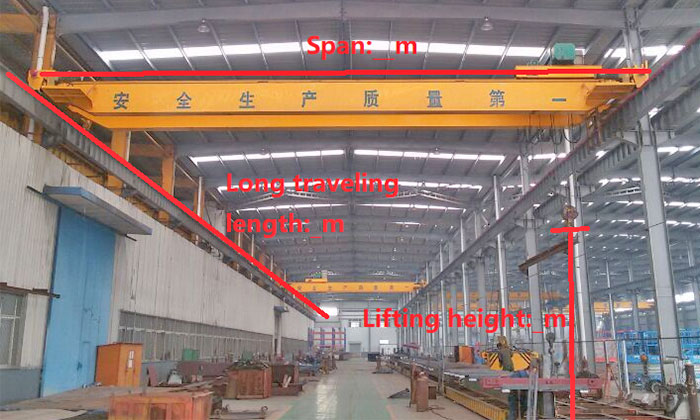
Main specifications required to confirm your crane: Crane Capacity, Crane Span, Crane Lifting height, and Crane Travelling
Factors to Consider When Choosing a 35 Ton Overhead Crane
Choosing the right 35 ton overhead crane for your specific needs requires careful consideration of various factors to ensure optimal performance, safety, and efficiency. Let's delve into these factors in more detail:
Load Characteristics
- Weight: Determine the maximum weight of the loads you need to lift and ensure that the crane's lifting capacity exceeds this weight to accommodate potential load variations.
- Dimensions: Consider the size and shape of the loads, including length, width, and height, to ensure that the crane's hook path and lifting height are sufficient for safe and efficient handling.
- Material: Identify the material composition of the loads to assess any special handling requirements, such as corrosive or abrasive materials that may require additional protective measures.
Operational Environment
Indoor vs. Outdoor:
Determine whether the crane will be installed indoors or outdoors and select a crane with appropriate weatherproofing and corrosion resistance for outdoor use.
- Temperature and Weather Conditions: Consider the ambient temperature range and prevailing weather conditions in the crane's operating environment to ensure that it can withstand extreme temperatures, humidity, and exposure to elements.
- Presence of Hazardous Materials: If the crane will be used in environments with hazardous materials or atmospheres, such as chemical plants or oil refineries, choose a crane with explosion-proof features and suitable material compatibility to mitigate safety risks.
Frequency of Use
- Daily Operation Hours: Assess the expected daily usage of the crane and select a crane with a suitable duty cycle rating to ensure reliable performance and longevity under the anticipated workload.
- Duty Cycle Requirements: Determine the duty cycle requirements, such as continuous or intermittent operation, and choose a crane with a duty cycle rating that matches these requirements to avoid premature wear and downtime.
Space Constraints
- Facility Layout: Evaluate the layout of your facility, including ceiling height, column spacing, and aisle width, to ensure that the crane's dimensions and operating range fit within the available space without obstructing other operations.
- Headroom and Span: Consider the required hook height and horizontal span of the crane to ensure that it can reach all desired work areas and accommodate load movement without interference from obstacles or obstructions.
Safety Requirements
- Compliance with Safety Standards: Ensure that the chosen crane complies with relevant safety standards and regulations, such as ANSI/ASME B30.2 for overhead cranes, to minimize safety risks and liability exposure.
- Operator Training: Provide adequate training for crane operators to ensure safe and proficient operation, including proper load handling techniques, safety procedures, and emergency protocols.
By carefully considering these factors when choosing a 35 ton overhead crane, you can select the most suitable crane configuration and features to meet your specific application requirements and operational needs effectively. Prioritizing safety, efficiency, and reliability will help maximize the performance and longevity of your overhead crane system.
Conclusion
In conclusion, 35 ton overhead cranes are indispensable assets in a wide range of industries, providing efficient and reliable material handling solutions for heavy loads and large-scale operations. From manufacturing and construction to automotive, mining, energy, and warehouse logistics, these cranes play a pivotal role in facilitating production processes, enhancing productivity, and ensuring workplace safety.
Throughout this comprehensive guide, we've explored the various types of 35 ton overhead cranes, their typical applications, and factors to consider when choosing the right crane for specific needs. We've highlighted the importance of understanding load characteristics, operational environments, frequency of use, space constraints, and safety requirements in crane selection to optimize performance and ensure operational success.
Furthermore, we've examined the diverse applications of 35 ton overhead cranes in different industries, showcasing their versatility and adaptability to various material handling tasks, from lifting heavy machinery and raw materials to assembling components and transporting goods. Real-world case studies have illustrated the practical implementation of overhead cranes in solving industry-specific challenges and achieving operational excellence.




